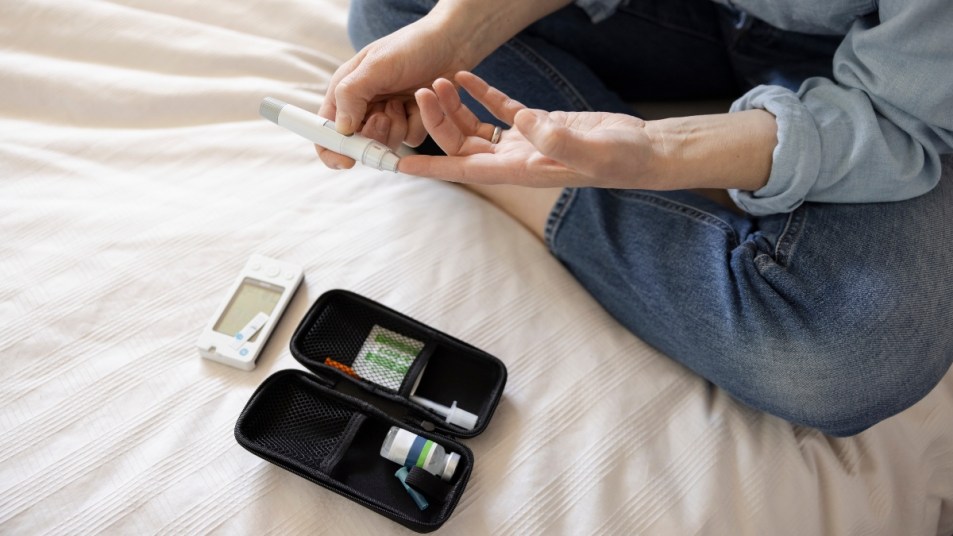Are At-Home Food Sensitivity, Vitamin, and Gut Health Tests Worth It?
It's convenient and theoretically easy — but it may not be worth your money.

You’ve probably seen a plethora of ads for food sensitivity, vitamin, or gut health testing kits on Facebook and Instagram lately. Different companies now offer at-home tests that claim to analyze your food sensitivities, vitamin levels, and overall gut health from the convenience of your home — which is much easier than visiting your doctor. But how do these kits work, and are they accurate? We did some research to uncover the pros and cons and help you make the right choice for your health.
Understanding Food Sensitivity, Vitamin, and Gut Health Testing Kits
Here’s how most testing kits work: First, order the test kit online, either using money out of pocket or funds from an HSA or FSA account. The kit ships to your home. Once you open it, read the instructions and provide a sample. (The sample is usually blood — a finger prick’s worth. For some gut testing kits, you may need to provide a stool sample.) Then, send the sample to a lab (the company provides the address for testing). In two to three weeks, you will get either a text or email notification that your results are ready and available to view online.
The results are in clear, easy-to-understand language. For example:
- The results of a food-sensitivity kit will tell you which foods in your diet trigger your body to create antibodies. (This means your body has developed an intolerance to that particular food.)
- The results of a vitamin testing kit will tell you whether your blood levels of certain nutrients (like vitamin D) are in an “acceptable” range.
- The results of a gut health test will tell you whether you have a good balance of gut bacteria.
Pros of At-Home Testing Kits
The primary argument for at-home testing kits? They’re convenient. You never have to leave your house for doctor’s appointments, and the results are available online. Some companies also have physicians review and interpret the test results, and that physician’s advice is then used to offer you health suggestions. Their advice can be as simple as “eliminate almonds from your diet,” or it may suggest specific products: “Buy our supplement to boost your vitamin levels.”
Some kits can also help you assess issues that are often difficult to diagnose. For instance, most doctors recommend following the “elimination diet” to figure out whether you have food intolerances; this involves cutting your diet down to a few core foods for two to four weeks and then reintroducing one food (such as eggs) to see if it incurs any symptoms. If it doesn’t, you can reintroduce another food the next week. While the elimination diet is free, it is long, tedious, and difficult. You will likely have to make most of your foods at home to ensure you’re aware of every ingredient you consume, and you may get tired of eating the same core foods every week. So, a food sensitivity testing kit could be a worthwhile alternative for you to consider, as it may help streamline the process.
Cons of At-Home Testing
Though at-home testing kits may help you determine conditions that are difficult to diagnose, there’s a downside: they may not be entirely accurate. All companies that sell kits claim they are highly accurate, and some provide data to back up their claims. However, The New York Times reported in September of 2021 that these kits — especially food sensitivity kits — are problematic. Firstly, doctors don’t agree on what defines a food sensitivity or a food intolerance. (They do agree that food allergies and autoimmune conditions, like celiac disease, are a completely different story.) Secondly, medical organizations like the American Academy of Allergy, Asthma, and Immunology state that there is no good evidence showing these testing kits work.
Furthermore, some at-home testing kits are easily replaced by an annual blood test. Annual blood testing is covered by most major insurance companies in the US. The Affordable Care Act (ACA) also mandated that blood, sweat, and urine tests be covered when they are testing nutrient levels (like vitamins), drug interactions, or the presence of certain medical conditions. Allergy testing and treatments are covered by most insurance plans as well. So, the safest bet is probably to request these tests from your doctor directly.
Bottom Line
If you feel that an at-home testing kit is worth it, talk to your doctor. Your insurance may not cover certain tests, so getting an at-home kit may be more affordable in some cases. Just be warned: At-home testing kits are not a substitute for a conversation with your primary care physician. (Even if you take a test, you still need to visit a doctor to get a real diagnosis.) If your physician won’t give you a script for a certain test, and you strongly believe you need it, consider making an appointment with a new doctor.












